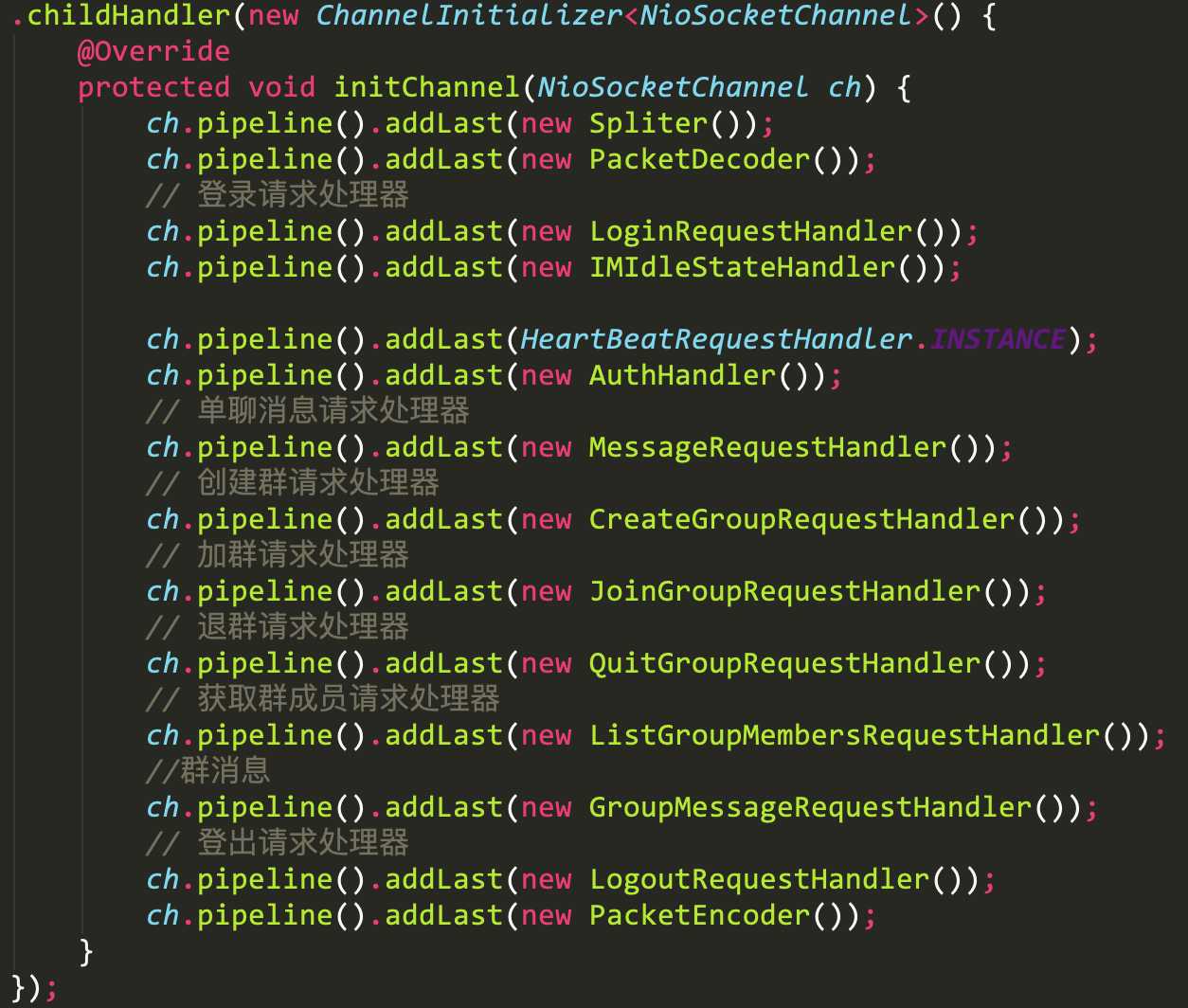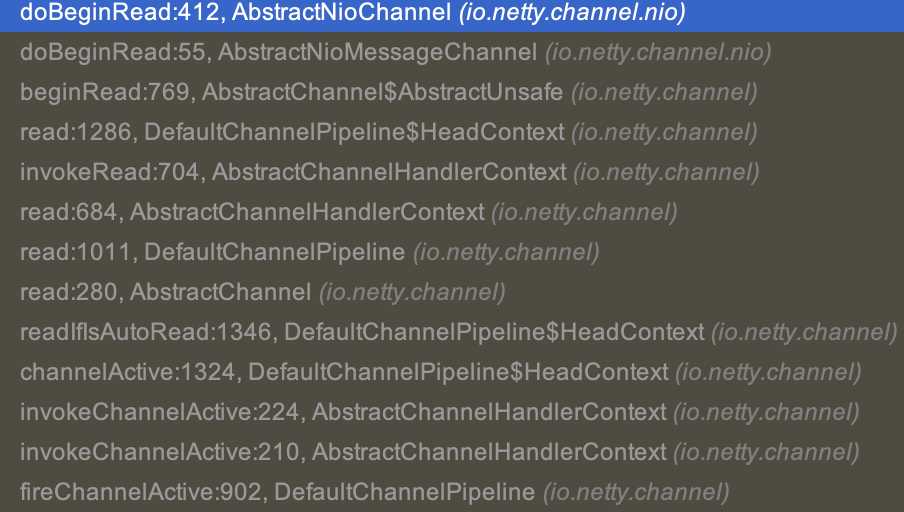Netty源码 新连接处理
Posted xmzjava
tags:
篇首语:本文由小常识网(cha138.com)小编为大家整理,主要介绍了Netty源码 新连接处理相关的知识,希望对你有一定的参考价值。
上文我们阐述了Netty的Reactor模型。在Reactor模型的第二阶段,Netty会处理各种io事件。对于客户端的各种请求就是在这个阶段去处理的。本文便来分析一个新的连接是如何被处理的。
代码的入口就从read方法开始。这里的unsafe的类型是NioMessageUnsafe,在服务端启动时就确定下来了。
if ((readyOps & (SelectionKey.OP_READ | SelectionKey.OP_ACCEPT)) != 0 || readyOps == 0) { unsafe.read(); if (!ch.isOpen()) { // Connection already closed - no need to handle write. return; } }
我们省去部分代码,read方法逻辑非常简单。就是一个读出加处理的过程
public void read() { assert eventLoop().inEventLoop(); final ChannelConfig config = config(); final ChannelPipeline pipeline = pipeline(); final RecvByteBufAllocator.Handle allocHandle = unsafe().recvBufAllocHandle(); allocHandle.reset(config); boolean closed = false; Throwable exception = null; do { //读取消息 int localRead = doReadMessages(readBuf); if (localRead == 0) { break; } if (localRead < 0) { closed = true; break; } allocHandle.incMessagesRead(localRead); } while (allocHandle.continueReading()); int size = readBuf.size(); for (int i = 0; i < size; i ++) { readPending = false; //循环处理消息 pipeline.fireChannelRead(readBuf.get(i)); } readBuf.clear(); allocHandle.readComplete(); //触发读取完毕事件 pipeline.fireChannelReadComplete(); }
1.读取消息
protected int doReadMessages(List<Object> buf) throws Exception { SocketChannel ch = javaChannel().accept(); try { if (ch != null) { buf.add(new NioSocketChannel(this, ch)); return 1; } } catch (Throwable t) { logger.warn("Failed to create a new channel from an accepted socket.", t); try { ch.close(); } catch (Throwable t2) { logger.warn("Failed to close a socket.", t2); } } return 0; }
在doReadMessages首先accept一个新连接,由于在一阶段的时候已经有io事件产生了,所以这里不会等待而是立即接受一个新连接并用SocketChannel表示。
接着又构造出了一个NiosocketChannel将java的channel封装成netty自己的channel并添加到list中,我们点进去看看。
public NioSocketChannel(Channel parent, SocketChannel socket) { super(parent, socket); config = new NioSocketChannelConfig(this, socket.socket()); }
protected AbstractNioByteChannel(Channel parent, SelectableChannel ch) { super(parent, ch, SelectionKey.OP_READ); }
protected AbstractNioChannel(Channel parent, SelectableChannel ch, int readInterestOp) { super(parent); this.ch = ch; this.readInterestOp = readInterestOp; try { ch.configureBlocking(false); } catch (IOException e) { try { ch.close(); } catch (IOException e2) { if (logger.isWarnEnabled()) { logger.warn( "Failed to close a partially initialized socket.", e2); } } throw new ChannelException("Failed to enter non-blocking mode.", e); } }
protected AbstractChannel(Channel parent) { this.parent = parent; id = newId(); unsafe = newUnsafe(); pipeline = newChannelPipeline(); }
最终我们到了AbstractChannel的类中,发现NioSocketChannel的建立会创建unsafe和pipeline。这里我们看下具体类型
unsafe的具体类型是由子类io.netty.channel.socket.nio.NioSocketChannel#newUnsafe决定的
protected AbstractNioUnsafe newUnsafe() { return new NioSocketChannelUnsafe(); }
pipeline则是默认的DefaultChannelPipeline
protected DefaultChannelPipeline(Channel channel) { this.channel = ObjectUtil.checkNotNull(channel, "channel"); succeededFuture = new SucceededChannelFuture(channel, null); voidPromise = new VoidChannelPromise(channel, true); tail = new TailContext(this); head = new HeadContext(this); head.next = tail; tail.prev = head; }
这里我们便引出了pipeline的概念,看上述代码便知pipeline的数据结构是一个双向链表。我们也可以把它想象成一个责任链或者更直白点就是流水线。任何连接请求都会通过pipeline处理最终返回到客户端。
现在显得连接已经封装成channel并添加到list中了,现在我们再看下消息处理
int size = readBuf.size(); for (int i = 0; i < size; i ++) { readPending = false; pipeline.fireChannelRead(readBuf.get(i)); }
2.消息处理
static void invokeChannelRead(final AbstractChannelHandlerContext next, Object msg) { final Object m = next.pipeline.touch(ObjectUtil.checkNotNull(msg, "msg"), next); EventExecutor executor = next.executor(); if (executor.inEventLoop()) { next.invokeChannelRead(m); } else { executor.execute(new Runnable() { @Override public void run() { next.invokeChannelRead(m); } }); } }
消息处理实际就是pipeline链式执行handle的过程。那么对于服务端的channel,他在接受新连接的时候先执行那个handle呢。服务端处理新连接的pipeline中,已经自动添加了一个pipeline处理器 ServerBootstrapAcceptor
所以我们先看下ServerBootstrapAcceptor的channelRead方法
public void channelRead(ChannelHandlerContext ctx, Object msg) { //1.泛型转换新连接创建的channel final Channel child = (Channel) msg; //2.设置channel的handler child.pipeline().addLast(childHandler); for (Entry<ChannelOption<?>, Object> e: childOptions) { try { if (!child.config().setOption((ChannelOption<Object>) e.getKey(), e.getValue())) { logger.warn("Unknown channel option: " + e); } } catch (Throwable t) { logger.warn("Failed to set a channel option: " + child, t); } } for (Entry<AttributeKey<?>, Object> e: childAttrs) { child.attr((AttributeKey<Object>) e.getKey()).set(e.getValue()); } try { //channel绑定到一个raector线程上 childGroup.register(child).addListener(new ChannelFutureListener() { @Override public void operationComplete(ChannelFuture future) throws Exception { if (!future.isSuccess()) { forceClose(child, future.cause()); } } }); } catch (Throwable t) { forceClose(child, t); } }
1.将刚刚创建的channel泛型转换出来
2.调用用户代码的childHandler属性,注意,这里只是添加了一个ChannelInitializer,相应的初始化还未运行,

3.注册该channel,将该channel绑定到一个reactor线程,后续关于这个channel的事件,任务都是由该reactor线程处理。
现在我们点进注册的代码
public ChannelFuture register(Channel channel) { return next().register(channel); }
public EventLoop next() { return (EventLoop) super.next(); }
next方法返回的是一个reactor线程,我们看下netty是如何挑选线程的。点击super.next
public EventExecutor next() { return chooser.next(); }
这里出现一个chooser代表的是一个选择策略,下面直接上代码了
chooser = chooserFactory.newChooser(children);
public EventExecutorChooser newChooser(EventExecutor[] executors) { if (isPowerOfTwo(executors.length)) { return new PowerOfTowEventExecutorChooser(executors); } else { return new GenericEventExecutorChooser(executors); } }
netty根据线程数量的奇偶性 会选择出不同的选择策略。两者唯一的区别就是一个是与运算,一个是取余
private static final class PowerOfTowEventExecutorChooser implements EventExecutorChooser { private final AtomicInteger idx = new AtomicInteger(); private final EventExecutor[] executors; PowerOfTowEventExecutorChooser(EventExecutor[] executors) { this.executors = executors; } @Override public EventExecutor next() { return executors[idx.getAndIncrement() & executors.length - 1]; } } private static final class GenericEventExecutorChooser implements EventExecutorChooser { private final AtomicInteger idx = new AtomicInteger(); private final EventExecutor[] executors; GenericEventExecutorChooser(EventExecutor[] executors) { this.executors = executors; } @Override public EventExecutor next() { return executors[Math.abs(idx.getAndIncrement() % executors.length)]; } }
在我们确定一个reactor线程之后,我们便开始了注册的流程
io.netty.channel.SingleThreadEventLoop#register(io.netty.channel.Channel)
public ChannelFuture register(Channel channel) { return register(new DefaultChannelPromise(channel, this)); }
io.netty.channel.AbstractChannel.AbstractUnsafe#register
public final void register(EventLoop eventLoop, final ChannelPromise promise) { AbstractChannel.this.eventLoop = eventLoop; if (eventLoop.inEventLoop()) { register0(promise); } else { try { eventLoop.execute(new Runnable() { @Override public void run() { register0(promise); } }); } catch (Throwable t) { logger.warn( "Force-closing a channel whose registration task was not accepted by an event loop: {}", AbstractChannel.this, t); closeForcibly(); closeFuture.setClosed(); safeSetFailure(promise, t); } } }
注册的核心代码便是register0了
private void register0(ChannelPromise promise) { try { // check if the channel is still open as it could be closed in the mean time when the register // call was outside of the eventLoop if (!promise.setUncancellable() || !ensureOpen(promise)) { return; } boolean firstRegistration = neverRegistered; doRegister(); neverRegistered = false; registered = true; pipeline.invokeHandlerAddedIfNeeded(); safeSetSuccess(promise); pipeline.fireChannelRegistered(); if (isActive()) { if (firstRegistration) { pipeline.fireChannelActive(); } else if (config().isAutoRead()) { beginRead(); } } } catch (Throwable t) { // Close the channel directly to avoid FD leak. closeForcibly(); closeFuture.setClosed(); safeSetFailure(promise, t); } }
- doRegister之前在服务端分析时有过讲解,这里真正的吧channel与reactor线程绑定在一起
- pipeline.invokeHandlerAddedIfNeeded();
为channel添加Handler,这里将添加handler任务包装成Task
private final class PendingHandlerAddedTask extends PendingHandlerCallback { PendingHandlerAddedTask(AbstractChannelHandlerContext ctx) { super(ctx); } @Override public void run() { callHandlerAdded0(ctx); } @Override void execute() { EventExecutor executor = ctx.executor(); if (executor.inEventLoop()) { callHandlerAdded0(ctx); } else { try { executor.execute(this); } catch (RejectedExecutionException e) { if (logger.isWarnEnabled()) { logger.warn( "Can‘t invoke handlerAdded() as the EventExecutor {} rejected it, removing handler {}.", executor, ctx.name(), e); } remove0(ctx); ctx.setRemoved(); } } } }
最终调用io.netty.channel.ChannelInitializer#handlerAdded
private void callHandlerAdded0(final AbstractChannelHandlerContext ctx) { ctx.handler().handlerAdded(ctx); ctx.setAddComplete(); }
public void handlerAdded(ChannelHandlerContext ctx) throws Exception { if (ctx.channel().isRegistered()) { initChannel(ctx); } }
这也就是我们的用户代码

- pipeline.fireChannelRegistered(); channel注册完之后的回调
- pipeline.fireChannelActive() channel激活的回调
到这里其实已经接近尾声了。但是我们的channel目前还是无法使用的。因为他并没有注册他感兴趣的事件。他现在是一个没有梦想的channel。所以我们看下channel激活的具体逻辑
private void invokeChannelActive() { if (invokeHandler()) { try { ((ChannelInboundHandler) handler()).channelActive(this); } catch (Throwable t) { notifyHandlerException(t); } } else { fireChannelActive(); } } public void channelActive(ChannelHandlerContext ctx) throws Exception { ctx.fireChannelActive(); readIfIsAutoRead(); } private void readIfIsAutoRead() { if (channel.config().isAutoRead()) { channel.read(); } } public Channel read() { pipeline.read(); return this; } public final ChannelPipeline read() { tail.read(); return this; } ....... protected void doBeginRead() throws Exception { // Channel.read() or ChannelHandlerContext.read() was called final SelectionKey selectionKey = this.selectionKey; if (!selectionKey.isValid()) { return; } readPending = true; final int interestOps = selectionKey.interestOps(); if ((interestOps & readInterestOp) == 0) { selectionKey.interestOps(interestOps | readInterestOp); } }

最终在io.netty.channel.nio.AbstractNioChannel#doBeginRead中设置selectionKey对读事件感兴趣。
以上便是netty对新连接的处理
参考
https://www.jianshu.com/p/0242b1d4dd21 【netty源码分析之新连接接入全解析】
以上是关于Netty源码 新连接处理的主要内容,如果未能解决你的问题,请参考以下文章